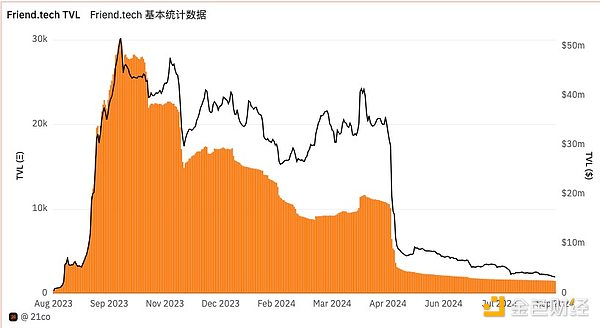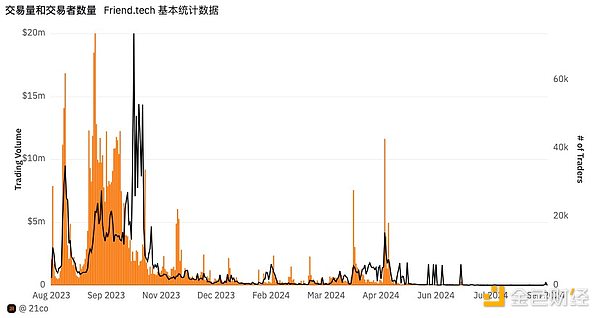Jessy, Jinse Finance
Friend.Tech has run away.
According to The Block, the developers of the Web3 social network Friend.Tech, which was established just one year ago, gave up control of the smart contract and the platform has been shut down. According to data monitoring by on-chain data analysts, the project owner earned $52.4 million through the project.
Friend.Tech set a record of daily revenue exceeding Ethereum within a month of its establishment. It was extremely popular and had numerous imitations. But the other side of the coin that is not known to the public is that after the project reached its peak after the rapid development in the first three months, it has been on a downward slope since then. First of all, the number of protocol users has basically not increased significantly, the TVL of the protocol has also been falling, the transaction volume has plummeted, and the lowest daily active users were only a dozen or so.
Looking back at Friend.Tech’s development history over the past year, we can see that it has not been able to shake off the negative comments it received from its inception, such as “Ponzi scheme”, “casino”, and “unsustainable business model”. Within a year, its version updates, coin issuance, and other actions were only short-term survival behaviors.
Since star projects like Friend.Tech have failed, does this prove that the Socialfi track is just a false proposition?
Projects suitable for KOLs to open “marketing”
As a decentralized social platform, Friend.Tech is strongly bound to X, allowing users to obtain the right to communicate directly with any user on Friend.Tech through the user's share - Key, and the Key can also be resold. For buyers, they can bet on the future potential of the user by purchasing the Key.
Moreover, users can issue their own personal tokens on Friend.Tech, and users holding personal tokens can obtain exclusive content from the issuer.
This seems to be a platform that allows creators to monetize their content. Compared with other platforms, it helps users save a lot of tedious processes in operating content. In fact, it is a simple and crude way for users to directly monetize their connections.
Its product design is simple enough, and at first it only had the functions of adding friends and joining group chats. It is built on the large traffic pool of X, and the platform's built-in airdrop expectations are also attractive enough. It promotes interaction and dissemination among users through invitation codes and points.
Friend.Tech also allows personal influence to be equityized and traded by setting a price curve. This mechanism design refers to the practice in AMM, that is, price discovery and fluctuation can be achieved without a large number of transactions. This method gives personal influence a certain economic value. The user's stock price can be automatically discovered and adjusted according to the price curve under the condition of sufficient liquidity. Even in the case of low trading volume, personal stock prices can be reasonably reflected. This influence pricing and trading mechanism is the core innovation of Friend.Tech compared to traditional social tokens.
In general, the project seems to be born for KOLs in terms of its dissemination mechanism. That is why, through the massive dissemination of KOLs, it spreads rapidly in a short period of time. Similarly, its pricing method for individual "Keys" is also innovative with reference to the AMM model. This has enabled the project to quickly break through the circle. KOLs and project parties have made a lot of money.
On a certain day in September 2023, it set a record of daily revenue surpassing Ethereum. According to the analysis created by Dune user @21co, its TVL locked volume peaked in October 2023 at 51.68 million US dollars.

Using the mindset of running a casino to do social networking is doomed to failure
The first three months were Friend.Tech’s most glorious period. After October 2023, Friend.Tech began to decline.
Is the price curve pushed up in the short term sustainable? In fact, many users only speculate or get token incentives, which makes Friend.Tech have such active transactions in the short term. How to maintain long-term user stickiness?
Friend.Tech’s transaction volume this year also proves that the project itself is unsustainable and has failed to retain users.

According to an analysis created by Dune user @21co, its highest trading volume was in the first three months, after which it became quiet, with the second relative high being in May 2024.
At that time, Friend.Tech launched the V2 version and issued the platform currency FRIEND, which can be redeemed for points on the platform. At the same time, the project also announced that in addition to the 100 million points initially established, 12 million FRIEND incentives will be allocated to LP providers in the next 12 months.
Although the transaction volume and daily activity on the Friend.Tech platform are not as good as they were when it was first established, the market value of FRIEND has exceeded 200 million US dollars in a short period of time after its launch, and the transaction volume of FRIEND has reached 100 million US dollars within a week of its launch. In addition, Friend.Tech provides generous rewards to LPs, which also attracts more FRIEND token liquidity locks, among which Huang Licheng is the largest LP of FRIEND tokens. (According to the information on the chain, Machi Big Brother Licheng currently holds a total of 11.1 million FRIENDs, and has currently suffered a floating loss of at least 15 million US dollars.)
Friend.Tech V2 has launched the paid group "Club" function. The paid transactions of Club only support the platform currency FRIEND. The platform charges a handling fee during the transaction.
Although the launch of V2 and the token airdrop brought some users to the platform, these so-called "innovations" did not save Friend.Tech from its decline. The protocol fees began to stagnate soon after. According to data from The Block, V2 has only generated about $60,000 in protocol fees since June 2024. In July 2024, its daily active users were as low as 15.
At its core, the project is unsustainable.
The core of this project is to turn personal connections into resources. When the connections are exhausted, how can the project continue to develop? If you want to develop continuously, you need to continuously iterate the product and build a business capability that can continue to make money.
The launch of V2 was an attempt by Friend.Tech to iterate, but it was not successful. Friend.Tech itself is still a "casino" and "Ponzi scheme" built by consuming connections. From a profit perspective, these two characteristics are actually not a problem. In the early days, "Ponzi schemes" were used to continuously attract people, expand the market, and inject traffic into the casino. The initial traffic was there, and the casino could continue to operate. The core is that new plates need to appear continuously, and the project party just needs to continue to earn commissions in the meantime.
Unfortunately, Friend.Tech failed to continue to attract people to open the market. Because the product itself is deformed, it is not a pure casino, it is a social product. The market is opened by KOLs, and the chips are his Key. But the number of influential KOLs is limited, and only the "market opened by influential KOLs" has higher liquidity. No one buys ordinary KEY. Without new KOLs to open the market, the project will no longer be active, and the project owner will find it difficult to make money.
If it is a simple casino that allows people to issue coins, similar to Pump.fun, it can survive well. However, using social networking and casinos actually greatly raises the threshold for issuing coins.
If we look at it from the perspective of a social product, we will find that people who enter this project are basically not here for socializing, but to monetize their connections, or to make money by buying and selling tokens.
From this perspective, the project is just a casino packaged as a social product, but the casino is not simple and pure. Such a deformed product is bound to fail.
Is Socialfi a false proposition?
The failure of Friend.Tech has caused people in the industry to wonder: Is “SocialFi” a false proposition?
If social networking is only for making money, it will definitely fail, and Friend.Tech has proved this. The first attribute that a good social networking product needs to satisfy must be people’s social needs.
On this basis, Web3's social products need to compete with Web2's social products and meet social needs that are difficult to meet on other platforms, so that people will be willing to migrate.
Web3 social products should put aside the value propositions of Web3 and how to allow users to make money through social interaction. The priority should be on how to create a product that can meet a certain social need of most people.
People’s social needs have not changed: sex, communication, and relationship maintenance are the most basic needs. Above that are the needs to own or monetize social assets such as connections, high-quality content, etc.
To develop social products, you need to first meet the most basic needs, and then work on the upper layer. The advantage of blockchain is that it can make the things required by the upper layer into personal real assets.
Socialfi itself may not be a false proposition, but the reality is that many current projects, without meeting the underlying needs, blindly build the upper layer, which will inevitably fall into the unsustainable Ponzi model of quick success and instant benefits, or fail to create any waves and have few users.
There is definitely a demand for Web3 social networking. With the increase in blockchain users and people's emphasis on personal social assets, the original Web2 social products can no longer meet all of people's social needs.
Telegram's success in meeting some of the Web3 needs of blockchain users, such as on-chain interaction, blockchain asset storage, and transactions, also proves that Web3 social networking itself has demand and market.
Socialfi will also have it, and everyone is waiting for a successful product.







